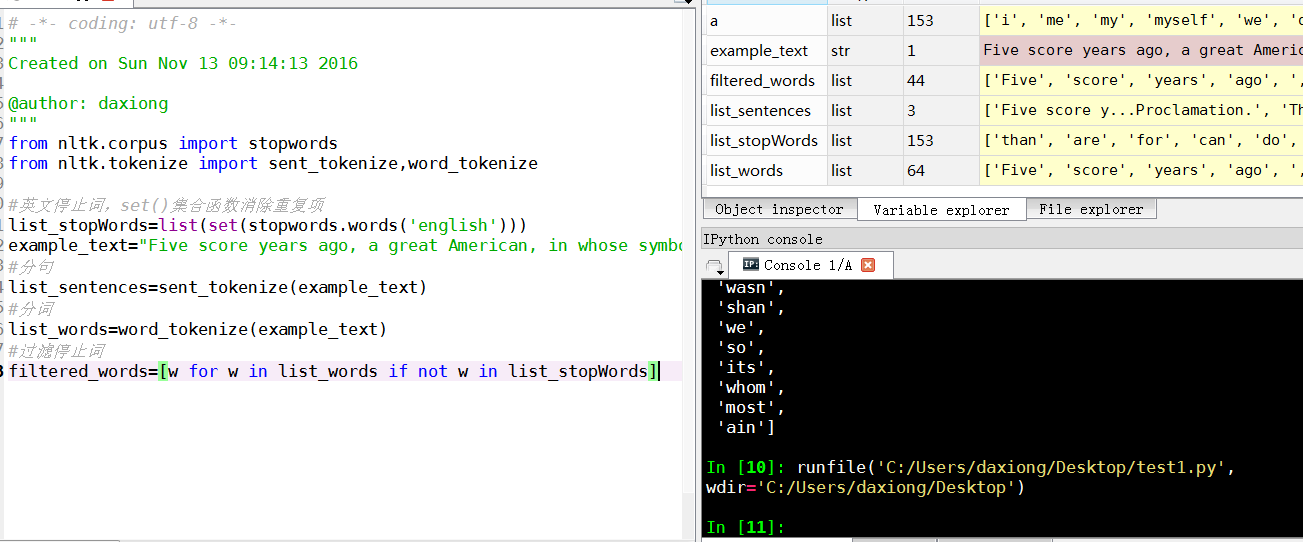自然语言13_Stop words with NLTK
python机器学习-乳腺癌细胞挖掘(博主亲自录制视频)https://study.163.com/course/introduction.htm?courseId=1005269003&utm_campaign=commission&utm_source=cp-400000000398149&utm_medium=share
# -*- coding: utf-8 -*-
"""
Created on Sun Nov 13 09:14:13 2016 @author: daxiong
"""
from nltk.corpus import stopwords
from nltk.tokenize import sent_tokenize,word_tokenize #英文停止词,set()集合函数消除重复项
list_stopWords=list(set(stopwords.words('english')))
example_text="Five score years ago, a great American, in whose symbolic shadow we stand today, signed the Emancipation Proclamation. This momentous decree came as a great beacon light of hope to millions of Negro slaves who had been seared in the flames of withering injustice. It came as a joyous daybreak to end the long night of bad captivity."
#分句
list_sentences=sent_tokenize(example_text)
#分词
list_words=word_tokenize(example_text)
#过滤停止词
filtered_words=[w for w in list_words if not w in list_stopWords]

Stop words with NLTK
The idea of Natural Language Processing is to do some form of
analysis, or processing, where the machine can understand, at least to
some level, what the text means, says, or implies.
This is an obviously massive challenge, but there are steps to
doing it that anyone can follow. The main idea, however, is that
computers simply do not, and will not, ever understand words directly.
Humans don't either *shocker*. In humans, memory is broken down into
electrical signals in the brain, in the form of neural groups that fire
in patterns. There is a lot about the brain that remains unknown, but,
the more we break down the human brain to the basic elements, we find
out basic the elements really are. Well, it turns out computers store
information in a very similar way! We need a way to get as close to that
as possible if we're going to mimic how humans read and understand
text. Generally, computers use numbers for everything, but we often see
directly in programming where we use binary signals (True or False,
which directly translate to 1 or 0, which originates directly from
either the presence of an electrical signal (True, 1), or not (False,
0)). To do this, we need a way to convert words to values, in numbers,
or signal patterns. The process of converting data to something a
computer can understand is referred to as "pre-processing." One of the
major forms of pre-processing is going to be filtering out useless data.
In natural language processing, useless words (data), are referred to
as stop words.
Immediately, we can recognize ourselves that some words carry more
meaning than other words. We can also see that some words are just
plain useless, and are filler words. We use them in the English
language, for example, to sort of "fluff" up the sentence so it is not
so strange sounding. An example of one of the most common, unofficial,
useless words is the phrase "umm." People stuff in "umm" frequently,
some more than others. This word means nothing, unless of course we're
searching for someone who is maybe lacking confidence, is confused, or
hasn't practiced much speaking. We all do it, you can hear me saying
"umm" or "uhh" in the videos plenty of ...uh ... times. For most
analysis, these words are useless.
We would not want these words taking up space in our database, or
taking up valuable processing time. As such, we call these words "stop
words" because they are useless, and we wish to do nothing with them.
Another version of the term "stop words" can be more literal: Words we
stop on.
For example, you may wish to completely cease analysis if you
detect words that are commonly used sarcastically, and stop immediately.
Sarcastic words, or phrases are going to vary by lexicon and corpus.
For now, we'll be considering stop words as words that just contain no
meaning, and we want to remove them.
You can do this easily, by storing a list of words that you
consider to be stop words. NLTK starts you off with a bunch of words
that they consider to be stop words, you can access it via the NLTK
corpus with:
from nltk.corpus import stopwords
Here is the list:
{'ourselves', 'hers', 'between', 'yourself', 'but', 'again', 'there',
'about', 'once', 'during', 'out', 'very', 'having', 'with', 'they',
'own', 'an', 'be', 'some', 'for', 'do', 'its', 'yours', 'such', 'into',
'of', 'most', 'itself', 'other', 'off', 'is', 's', 'am', 'or', 'who',
'as', 'from', 'him', 'each', 'the', 'themselves', 'until', 'below',
'are', 'we', 'these', 'your', 'his', 'through', 'don', 'nor', 'me',
'were', 'her', 'more', 'himself', 'this', 'down', 'should', 'our',
'their', 'while', 'above', 'both', 'up', 'to', 'ours', 'had', 'she',
'all', 'no', 'when', 'at', 'any', 'before', 'them', 'same', 'and',
'been', 'have', 'in', 'will', 'on', 'does', 'yourselves', 'then',
'that', 'because', 'what', 'over', 'why', 'so', 'can', 'did', 'not',
'now', 'under', 'he', 'you', 'herself', 'has', 'just', 'where', 'too',
'only', 'myself', 'which', 'those', 'i', 'after', 'few', 'whom', 't',
'being', 'if', 'theirs', 'my', 'against', 'a', 'by', 'doing', 'it',
'how', 'further', 'was', 'here', 'than'}
Here is how you might incorporate using the stop_words set to remove the stop words from your text:
from nltk.corpus import stopwords
from nltk.tokenize import word_tokenize example_sent = "This is a sample sentence, showing off the stop words filtration." stop_words = set(stopwords.words('english')) word_tokens = word_tokenize(example_sent) filtered_sentence = [w for w in word_tokens if not w in stop_words] filtered_sentence = [] for w in word_tokens:
if w not in stop_words:
filtered_sentence.append(w) print(word_tokens)
print(filtered_sentence)
Our output here:['This', 'is', 'a', 'sample', 'sentence', ',', 'showing', 'off', 'the', 'stop', 'words', 'filtration', '.']
['This', 'sample', 'sentence', ',', 'showing', 'stop', 'words', 'filtration', '.']
Our database thanks us. Another form of data pre-processing is 'stemming,' which is what we're going to be talking about next.
自然语言13_Stop words with NLTK的更多相关文章
- 自然语言处理(1)之NLTK与PYTHON
自然语言处理(1)之NLTK与PYTHON 题记: 由于现在的项目是搜索引擎,所以不由的对自然语言处理产生了好奇,再加上一直以来都想学Python,只是没有机会与时间.碰巧这几天在亚马逊上找书时发现了 ...
- 自然语言23_Text Classification with NLTK
QQ:231469242 欢迎喜欢nltk朋友交流 https://www.pythonprogramming.net/text-classification-nltk-tutorial/?compl ...
- 自然语言20_The corpora with NLTK
QQ:231469242 欢迎喜欢nltk朋友交流 https://www.pythonprogramming.net/nltk-corpus-corpora-tutorial/?completed= ...
- 自然语言19.1_Lemmatizing with NLTK(单词变体还原)
QQ:231469242 欢迎喜欢nltk朋友交流 https://www.pythonprogramming.net/lemmatizing-nltk-tutorial/?completed=/na ...
- 自然语言14_Stemming words with NLTK
https://www.pythonprogramming.net/stemming-nltk-tutorial/?completed=/stop-words-nltk-tutorial/ # -*- ...
- 自然语言处理2.1——NLTK文本语料库
1.获取文本语料库 NLTK库中包含了大量的语料库,下面一一介绍几个: (1)古腾堡语料库:NLTK包含古腾堡项目电子文本档案的一小部分文本.该项目目前大约有36000本免费的电子图书. >&g ...
- python自然语言处理函数库nltk从入门到精通
1. 关于Python安装的补充 若在ubuntu系统中同时安装了Python2和python3,则输入python或python2命令打开python2.x版本的控制台:输入python3命令打开p ...
- Python自然语言处理实践: 在NLTK中使用斯坦福中文分词器
http://www.52nlp.cn/python%E8%87%AA%E7%84%B6%E8%AF%AD%E8%A8%80%E5%A4%84%E7%90%86%E5%AE%9E%E8%B7%B5-% ...
- 推荐《用Python进行自然语言处理》中文翻译-NLTK配套书
NLTK配套书<用Python进行自然语言处理>(Natural Language Processing with Python)已经出版好几年了,但是国内一直没有翻译的中文版,虽然读英文 ...
随机推荐
- Beta版本冲刺———第二天
会议照片: 项目燃尽图: 1.项目进展: 昨天的困难:分数排行榜的设计 今天解决的进度:完成了界面优化以及建立新的排行榜选项卡界面. 明天要做的事情:分数排行榜的功能设计 2.每个人每天做的事情 郭怡 ...
- webservice的常用注解
定义说明书的显示方法1.@WebService(serviceName="PojoService", portName="PojoPort", name=&qu ...
- 网站移植到linux上后常犯的错误
常犯的错误 1:gcc库没装或者没装全 表现:没有可用的C编译器 同类错误:提示g++ not found, 解决:出现以上错误,则是因为gcc编译器没装,或者是没装全. 挂载光盘,到Pakeges里 ...
- 2016年GitHub 排名前 100 的安卓、iOS项目简介(收藏)
排名完全是根据 GitHub 搜索 Java 语言选择 (Best Match) 得到的结果, 然后过滤了跟 Android 不相关的项目, 所以排名并不具备任何官方效力, 仅供参考学习, 方便初学者 ...
- 【COGS 254】【POI 2001】交通网络图
http://www.cogs.top/cogs/problem/problem.php?pid=254 dist[i]表示能最早到达i点的时间.这样就可以用最短路模型来转移了. #include&l ...
- java中map<string,int>
java中 Iterator it=wordsmap.entrySet().iterator(); while(it.hasNext()) { Map.Entry<String,Integer& ...
- golang学习之旅:搭建go语言开发环境
从今天起,将学习go语言.今天翻了一下许式伟前辈写的<Go语言编程>中的简要介绍:Go语言——互联网时代的C语言.前面的序中介绍了Go语言的很多特性,很强大,迫不及待地想要一探究竟,于是便 ...
- 【BZOJ-1552&3506】robotic sort&排序机械臂 Splay
1552: [Cerc2007]robotic sort Time Limit: 5 Sec Memory Limit: 64 MBSubmit: 806 Solved: 329[Submit][ ...
- 【BZOJ-1923】外星千足虫 高斯消元 + xor方程组
1923: [Sdoi2010]外星千足虫 Time Limit: 10 Sec Memory Limit: 64 MBSubmit: 766 Solved: 485[Submit][Status ...
- Linux su和sudo命令的区别,并获得root权限
su(superuser) su表示切换用户,如: 输入:su命令后回车表示切换当前的用户到root用户,或者: 输入:su - root(或者其他用户名)这里加了"-"后表示也切 ...


